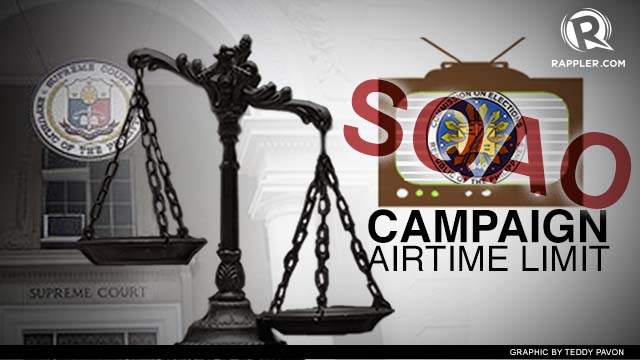SUMMARY
This is AI generated summarization, which may have errors. For context, always refer to the full article.

BAGUIO CITY, Philippines – The Supreme Court stopped the Commission on Elections (Comelec) on Tuesday, April 16, from implementing its airtime limits on political ads.
Voting 9-6, the SC issued a status quo ante order that stopped the implementation of Comelec Resolution No. 9615 and its amendment, Resolution No. 9631.
The order comes barely a month before the May 13 elections, during the home stretch of which, senatorial candidates scramble for paid airtime to maximize their name recall.
The Comelec under chairman Sixto Brillantes Jr has set the following airtime cap for political ads, being faithful to the intent of the Fair Elections Act:
-
For all national candidates, an aggregate of 120 minutes in all TV networks and 180 minutes in all radio stations.
-
For all local candidates, an aggregate of 60 minutes in all TV networks and 90 minutes in all radio stations.
Broadcast networks GMA-7, TV5, and the Kapisanan ng Brodkaster ng Pilipinas sought a temporary restraining order on the Comelec rule in February, saying the limit is too “restrictive” and violates the people’s right to information. In previous elections, the Comelec under chair Benjamin Abalos imposed a more liberal interpretation of the law – 120 minutes per TV station, and 180 minutes per radio station.
The Comelec under Abalos previously computed the airtime limit on a per-station basis. This was in 2004, when President Gloria Arroyo, who appointed him, was running for president. This interpretation of the airtime limits pushed election spending to stratospheric heights. Reaping the windfall were the media outfits, particularly TV and radio.
In 2010 when the presidential and local polls were conducted, the top two TV giants — ABS-CBN and GMA 7 — reported record incomes. ABS-CBN said it earned P420 million from political ads in the first quarter of that year. GMA 7 said it reaped more than P2 billion in political ads during the course of the 2010 national polls.
Under Brillantes, the Comelec made an aggregate computation to “stick to the spirit” of the Fair Elections Act and set equal airtime for all candidates. The Comelec adopted the original airtime limits, as applied in the 2001 elections. (Read: Why revert to old airtime cap for candidates)
The Comelec’s “new” rule caught TV and radio stations by surprise, prompting some of them to go to the High Court, thus the status quo ante order. The order gives the justices time to hear the arguments of both sides.
The nine who concurred were Justices Antonio Carpio, Martin Villarama, Jose Mendoza,Lucas Bersamin, Justices Teresita Leonardo de Castro, Diosdado Peralta, Marvic Leonen, Presbitero Velasco, and Jose Perez.
“Information about candidates should reach every Filipino family, not only those with access to national TV,” Cayetano said. “This decision is a victory for voters, especially the poor in remote rural areas who now have the opportunity to hear more about the advocacy of various candidates.”
Add a comment
How does this make you feel?
There are no comments yet. Add your comment to start the conversation.